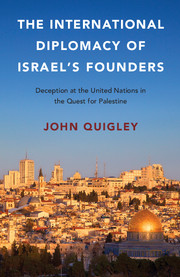 The International Diplomacy of Israel's Founders
The International Diplomacy of Israel's Founders Book contents
- Frontmatter
- Contents
- Preface
- A Note on United Nations Committees
- Abbreviations
- 1 A Public Relations Imperative
- 2 Promises, Promises
- 3 Pranks in Paris and Geneva
- 4 Courting the Commissar
- 5 Saving Europe's Jews – Our Way
- 6 Smoke and Mirrors at the YMCA
- 7 The Ship that Launched a Nation
- 8 Cocktails at the Consulate
- 9 Causing Chaos
- 10 Denying the Undeniable
- 11 A Peace-Loving State?
- 12 Joining the World with Fingers Crossed
- 13 Israel: 1, United Nations: 0
- 14 A Phantom Attack
- 15 Sabras in Sinai: Pardon My French
- 16 Suez Smoke-Screen
- 17 Mr. Nasser, Please Attack
- 18 Abba Eban's Finest Hour
- 19 Old Issues, New Lies
- 20 An Organization Turned Sinister
- 21 Prevarication Pays
- Notes
- Bibliography
- Index
17 - Mr. Nasser, Please Attack
Published online by Cambridge University Press: 05 January 2016
- Frontmatter
- Contents
- Preface
- A Note on United Nations Committees
- Abbreviations
- 1 A Public Relations Imperative
- 2 Promises, Promises
- 3 Pranks in Paris and Geneva
- 4 Courting the Commissar
- 5 Saving Europe's Jews – Our Way
- 6 Smoke and Mirrors at the YMCA
- 7 The Ship that Launched a Nation
- 8 Cocktails at the Consulate
- 9 Causing Chaos
- 10 Denying the Undeniable
- 11 A Peace-Loving State?
- 12 Joining the World with Fingers Crossed
- 13 Israel: 1, United Nations: 0
- 14 A Phantom Attack
- 15 Sabras in Sinai: Pardon My French
- 16 Suez Smoke-Screen
- 17 Mr. Nasser, Please Attack
- 18 Abba Eban's Finest Hour
- 19 Old Issues, New Lies
- 20 An Organization Turned Sinister
- 21 Prevarication Pays
- Notes
- Bibliography
- Index
Summary
The United Nations Emergency Force set up by the United Nations in 1957 remained in place on the Egyptian side of the Egypt-Israel armistice line for a decade. Then in May 1967, the situation in the region changed. Israel and Syria nearly came to blows over guerrilla raids from Syria and Israeli intrusions into a demilitarized zone that had been set up in the 1949 Syria-Israel armistice agreement. Israel charged Syria with provoking violence and filed a complaint with the United Nations in which it said it would retaliate in force if the violence continued. Syria in turn filed a complaint of its own at the United Nations about this threat. Egypt drew troops up to armistice line with Israel. Egypt asked the United Nations to remove the Emergency Force. U Thant, who became UN Secretary-General in 1961, ordered the Force to begin withdrawal. Egypt imposed restrictions on shipping entering the Gulf of Aqaba en route to the Israeli port of Eilat. Israel complained of these moves. It said that the shipping restrictions were illegal and that the troop movement, plus the request for removal of the Emergency Force, bespoke an Egyptian intent to invade Israel.
COAXING EGYPT TO INVADE
In late May 1967, as these events unfolded, the Government of Israel tentatively decided to attack the Egyptian troops and to invade Egypt. Egypt's forces were not well supplied, stationed far from central Egypt. Egypt had brought these troops up near the armistice line as a show of force, but they were ill prepared for battle. The IDF made a calculation, one that would turn out to be correct, that the Egyptian troops could not withstand an assault by the IDF. Crushing this huge contingent of Egyptian troops would diminish Egypt's warmaking capability for some time.
By now Abba Eban was Foreign Minister in a government led by Levi Eshkol as prime minister. Eshkol asked Eban to go to Washington to convince the United States that Egypt was about to invade Israel. The Government of Israel did not know how the United States might react if it invaded Egypt. Eban initiated the contact, in an effort to get the US imprimatur on an Israeli attack on Egypt. It worried that it might encounter the same reaction as it got from President Eisenhower when it carried out roughly the same invasion in 1956.
- Type
- Chapter
- Information
- The International Diplomacy of Israel's FoundersDeception at the United Nations in the Quest for Palestine, pp. 186 - 196Publisher: Cambridge University PressPrint publication year: 2016
